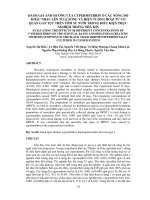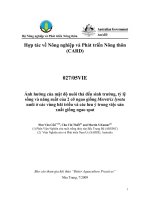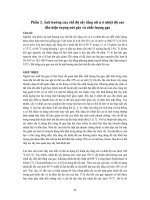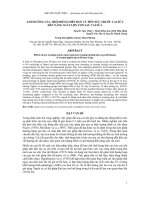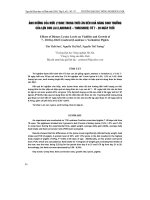Báo cáo nông nghiệp:" Ảnh hưởng của cai sữa sớm đến đến hồi phục sinh dục sau khi đẻ của trâu mẹ và sinh trưởng của nghé con" pot
Bạn đang xem bản rút gọn của tài liệu. Xem và tải ngay bản đầy đủ của tài liệu tại đây (706.43 KB, 6 trang )
J. Sci. Dev. 2011, 9 (Eng.Iss. 1): 41 - 46 HANOI UNIVERSITY OF AGRICULTURE
EFFECT OF EARLY WEANING ON POSTPARTUM RESUMPTION OF REPRODUCTION IN
MOTHER BUFFALOES AND GROWTH OF THEIR CALVES
Ảnh hưởng của cai sữa sớm đến đến hồi phục sinh dục sau khi đẻ của trâu mẹ
và sinh trưởng của nghé con
Cu Thi Thien Thu and Nguyen Xuan Trach
Faculty of Animal Science and Aquaculture, Hanoi University of Agriculture, Hanoi, Vietnam
Correspoding author email:
Received date: 21.02.2011 Accepted date: 14.04.2011
TÓM TẮT
Một thí nghiệm nhằm đánh giá ảnh hưởng của việc cai sữa sớm đến sự hồi phục hoạt động sinh
dục sau khi đẻ của trâu mẹ và sinh trưởng của nghé con đã được tiến hành đồng thời tại hai địa
phương có điều kiện chăn thả khác nhau là Hà Nam và Phú Thọ. Tại mỗi điểm 12 cặp trâu mẹ-con
được chọn và chia đều thành 2 nhóm: ở một nhóm nghé con được phép bú mẹ cho đến khi hết sữa
theo cách chăn nuôi truyền thống (lô đối chứng), còn ở nhóm kia nghé con được cai sữa lúc 120
ngày tuổi (lô thí nghiệm). Kết quả thí nghiệm cho thấy rằng cai sữa sớm giúp cho trâu mẹ rút ngắn
thời gian từ khi để đến khi động dục và có chửa lại. Sự phục hồi này đến sớm hơn ở nơi có điều kiện
dinh dưỡng tốt hơn. Thí nghiệm cũng cho thấy rằng mặc dù cai sữa sớm có kìm hãm sinh trưởng của
nghé con ở một mức độ nhất định ngay sau khi cai sữa, nhưng bê cai sữa sớm lại gặm cỏ nhiều hơn
và do vậy mà sau đó lại có tốc độ sinh trưởng cao hơn so với nghé không cai sữa.
Từ khoá: Cai sữa sớm, nghé, sinh sản, sinh trưởng, trâu.
SUMMARY
An experiment to determine effect of early weaning (EW) on postpartum resumption of
reproduction in mother buffaloes and growth of their calves was carried out concurrently in 2 localities
in North Vietnam, viz. Ha Nam and Phu Tho, with different grazing conditions. In each locality, 12
buffalo-calf pairs were equally allocated into 2 groups of 6 pairs each; in one group calves were allowed
to suck their mothers as long as they could according to the traditional practice (control group) and in
the other group (EW) calves were weaned at 120 days post calving (experimental group). Results
showed that early weaning improved postpartum reproduction in the mother buffaloes, shortening the
periods from calving to first estrus and to conception. Postpartum resumption of reproduction came
earlier in the locality with better nutritional conditions. It was also shown that although early weaning
suppressed calf growth to some extent right after weaning, the early weaned calves spent more time
grazing and thus grew faster later on compared to those in the control group.
Key word: Buffalo, calf, early weaning, growth, reproduction.
1. INTRODUCTION
In Vietnam, almost all buffaloes belong to
small holders. After birth, the calf is allowed to
follow its mother suckling until 1-2 years old
because the farmer has no way to wean the calf.
That may be one of the reasons for long calving
intervals in buffaloes as it has been proven that
suckling causes delayed postpartum resumption of
ovarian activity (Lamb et al., 1997) and removal of
the nursing calf results in hormonal changes in the
buffalo that stimulate estrus (Short et al., 1990,
Lamb et al., 1999). Beside hormonal changes,
buffaloes must have energy to support all bodily
activities, but some functions have a higher priority
for energy use than others. Buffaloes can only
direct energy toward resuming the estrous cycle
after calving if energy intake exceeds the combined
41
Effect of early weaning on postpartum resumption of reproduction in mother buffaloes and growth
requirements for maintenance, growth and lactation
(Rae et al., 1993). This is why body condition is
strongly related to the length of the postpartum
anestrous period in beef cattle (Laster, 1973;
Houghton et al., 1990). Since body condition
influences reproductive performance, early
weaning (EW) or restricted suckling can be utilized
to improve the chance that a buffalo is in an proper
body condition and thus reproduction post calving.
As far as the calf is concerned, the quantity of
mother milk in late lactation is very low and thus
energy supply is not enough for calf growth. In
addition, the suckling reflex inhibits the feeling of
hungry, and this will lead to the result that the calf
will be very thin and emaciated. At the same time,
if the calf is weaned late, the rumen should develop
very slowly because the main feed is mother’s
milk. When the calf begins to eat dry feed, the
rumen begins to supply nutrients produced by
fermentation and the population of rumen bacteria
begins to grow. The rumen bacteria themselves also
provide an important source of protein as they are
washed out of the rumen, digested, and absorbed in
the small intestine. Microbial protein is highly
digestible and contains a favorable profile of amino
acids relative to the needs of the growing calf. This
is the reason why the sooner dry feed is digested by
the calf, the sooner rumen development occurs and
early weaning improves cow-calf performance
(Randel, 1981; Peterson et al., 1987).
However, the above mentioned effects of early
weaning have been so far shown from studies on
cattle. Therefore, the present study was undertaken
to test the hypothesis that early weaning of the calf
could also shorten the postpartum interval in the
mother buffalo and enhance growth of the calf due
to better grass intake and digestion.
2. MATERIALS AND METHODS
The study was carried out from February to
August 2010 concurrently in 2 provinces in North
Vietnam, viz. Ha Nam (Boi Cau commune, Binh
Luc district) and Phu Tho (Huong Nha commune,
Tam Nong district), with different grazing
conditions. In Ha Nam natural green grass was
abundantly available; whereas, in Phu Tho
buffaloes were suffering from harsh grazing
conditions. In each of the two localities, 12 buffalo-
calf pairs were selected and equally allocated into 2
groups of 6 pairs each:
Group 1 (NW): Calves were allowed to suck
their mothers as long as they could according to the
traditional practice (the control).
Group 2 (EW): Calves were weaned at 120
days post calving, using a plastic anti-suckling
device until they completely forgot suckling
(Figure 1), being allowed to follow their mothers to
graze.
In each site, as it was not possible to select all
12 mother-calf pairs at one time, whenever two
pairs were found to be similar in terms of parity
(second to third calving), calving time (within 2
week), body condition of the mothers (±0.25 score),
and birth weight of the calves (±2.0 kg), they were
selected to put into the two groups to be monitored.
Only 12 those mother buffaloes not found having
returned to heat within 4 months post calving were
used for the purpose of the present study.
Figure 1. Plastic anti-suckling device
42
Cu Thi Thien Thu and Nguyen Xuan Trach
In both groups, the mother buffaloes were
allowed to graze natural grass along road sides and
common lands together with their calves as
traditionally practiced. Grazing time of the calves
was recorded individually 2 days a week from 120
days of their age. The calves were weighed at 120
days of age and every 15 days for three months
thereafter. The mother buffaloes were daily
observed for heat until 210 days postpartum by the
owner based on the signs of heat and the mounting
of the bull during grazing. After detecting a mother
buffalo showing standing heat, the farmer found a
bull from elsewhere for mating or let it mated
directly by bulls available on the common grazing
area. Heat observation was continued and
rebreeding was applied if the buffalo showed heat
again. Pregnancy was detected by rectal palpation
from 65 to 110 days after breeding.
Data were subjected to analyses of variance
(ANOVA) for a 2 x 2 factorial model with
interactions using the General Linear Model (GLM)
of Minitab 16. Pair-wise comparisons of means
were done using the Tukey method.
3. RESULTS AND DISCUSSION
Table 1 shows effects of EW on postpartum
reproduction in mother buffaloes and growth of
calves at two different localities. Statistical
analyses show that EW had a strong effect
(P<0.001) on the time from calving to first estrus,
reducing it by 24.8 days in Phu Tho and 48.2 days
in Ha Nam. Similarly, the time from calving to
conception was shortened by 32.8 and 46.7 days,
respectively, in the two localities as a result of EW
(P<0.01). The resumptions of estrus and conception
were also influenced by locality (P<0.05). The
interaction between EW and locality was also
significant (P<0.05), indicating that the effects of
EW on postpartum resumption of reproduction in
buffaloes would depend on the locality or, in other
words, the feeding condition.
It can also be seen from Table 1 that live
weight gain of the calves was strongly affected by
locality (P<0.001), indicating the importance of
grazing conditions. However, EW did not
significantly (P>0.05) affect weight gain of the
calves when calculated for a long time (75 days of
weaning). Nevertheless, a closer observation on
growth pattern of the calves after weaning (Table 2)
shows that EW did significantly influence the
growth pattern of the calf. Right after weaning
average daily gain (ADG) of the calves was
dramatically reduced compared to those not weaned
(NW), but later on ADG of the EW calves
gradually increased and reached a level higher than
that of the NW calf after a certain time (one month)
of weaning. This can be explained that after
weaning the calf received no nutrients from the
mother’s milk with a nutritionally stressful period
during which it had to rely on grazing for living,
resulting in retarded growth. However, when the
calf overcame this stressful period, it became
adapted to the new living condition and resumed
weight gain. The EW calves grew very fast then,
even faster than the NW, and as a result, they
became heavier later on (Figure 2) (should be all in
plural: calves).
Table 1. Effects of early weaning (EW) on postpartum resumption of reproduction in
mother buffaloes and growth of their calves in two different localities
Phu Tho Ha Nam Factor significance
With
EW
Without
EW
With
EW
Without
EW
SEM
Weaning Locality Interaction
Calving to 1
st
estrus (days) 173.2
b
198.0
a
150.5
c
198.7
a
4.8 *** * *
Calving to conception (days) 177.0
b
209.8
a
155.8
c
202.5
a
10.4 ** * *
Calf weight at 120 days of
age (kg)
81.9
a
79.2
a
92.7
a
93.0
a
1.4 NS *** NS
Calf weight at 195 days of
age (kg)
117.7
b
117.3
b
146.9
a
145.9
a
2.2 NS *** NS
Calf weight gain from 120 to
195 days of age (kg)
35.8
b
38.1
b
54.2
a
52.9
a
1.4 NS *** NS
NB. Means in the same row that do not share a letter are significantly different.
***: P<0.001; **: P<0.01; *: P<0.05; NS: non-significant.
43
Effect of early weaning on postpartum resumption of reproduction in mother buffaloes and growth
Table 2. Effect of early weaning (at 120 days of age) on the average daily gain (ADG) of
calves at two different localities (g/head/day)
Phu Tho Ha Nam Significance
Calf age
(days)
With EW
Without
EW
With EW
Without
EW
SEM
Weaning Locality Interaction
120-135 294.4
c
516.7
b
494.4
b
772.2
a
13.6 *** *** NS
135-150 394.4
d
472.2
c
605.6
b
688.9
a
18.2 *** *** NS
150-165 483.3
c
450.0
c
738.9
a
638.9
b
32.9 NS *** NS
165-180 572.2
c
500.0
d
850.0
a
672.2
b
27.4 *** *** NS
180-195 638.9
c
605.6
c
927.8
a
755.6
b
24.7 *** *** *
NB. Means in the same row that do not share a letter are significantly different.
***: P<0.001; **: P<0.01; *: P<0.05; NS: non-significant.
150
Calf age (days)
Calf weight
(kg)
With early weaning
Without early weaning
Weaning
80
90
100
140
130
120
110
120 135 150 165
180 195
210
Figure 2. Growth pattern of buffalo calves with and without
early weaning in Ha Nam
44
Cu Thi Thien Thu and Nguyen Xuan Trach
Figure 3. Daily grazing time spent by buffalo calves with and without early weaning
Figure 3 shows changes in grazing time of the
calf after weaning, that can help explain the earlier
mentioned changes in ADG and live weight. The
most critical time was the time right after weaning
as the calf had to overcome the stress of weaning.
In the first weeks of weaning, the EW calves spent
less time grazing than the NW ones. That was
probably because at the beginning of weaning, the
EW calves had to wear the anti-suckling device on
their nose, which was not comfortable for the
calves to graze. However, when the EW calves
forgot suckling and the device was removed, they
spent more and more time grazing to meet their
nutritional demands, and from 4 weeks of weaning
on the EW calves spent longer time grazing than
the NW, indicating that when relying on the
mother’s milk the NW calves did not feel so hungry
to graze as much as the EW. Since the EW calves
consumed more grass and utilized it better their
growth rate was higher than that of the NW in the
long run.
4. CONCLUSIONS
Early weaning is an effective way to shorten
postpartum resumption of reproduction in mother
buffaloes and enhance growth of their calves after a
short period of nutritional stress.
Acknowledgements
The authors are very grateful to the Swedish
International Development Cooperation Agency,
Department for Research Cooperation (Sida-
SAREC), through the regional MEKARN Project,
for the financial support of this study. Dr. T.R.
Preston is highly appreciated for his important
advices on the experimental design and data
analysis.
REFERENCES
Houghton, P. L., R. P. Lcmenager, L. A. Horstman,
K. S. Hendrix, and G. E. Moss (1990). Effects of
body condition, pre- and postpartum energy
level and early weaning on reproductive
performance of beef cows and preweaning calf
gain. J. Anim. Sci. 68:1438.
Lamb, G. C., J. M. Lynch, D. M. Grieger, J. E.
Minton, and J. S. Stevenson (1997). Ad libitum
suckling by an unrelated calf in the presence or
absence of a cow's own calf prolongs postpartum
anovulation. J. Anim. Sci. 75:2762.
45
Effect of early weaning on postpartum resumption of reproduction in mother buffaloes and growth
Lamb, G. C., B. L. Miller, J. M. Lynch, K. E.
Thompson, J. S. Heldt, C. A. Loest, D. M. Grieger,
and J. S. Stevenson (1999). Twice daily suckling
but not milking with calf presence prolongs
postpartum anovulation. J. Anim. Sci. 77:2207.
Laster, D. B., H. A. Glimp, and K. E. Gregory
(1973). Effects of early weaning on postpartum
reproduction of cows. J. Anim. Sci. 36:734.
Peterson, G. A., T. B. Turner, K. M. Irvin, M. E.
Davis, H. W. Newland, and W. R. Harvey
(1987). Cow and calf performance and economic
considerations of early weaning of fallborn beef
calves. J. Anim. Sci. 65:15.
Rae, D. O., W. E. Kunkle, P. J. Chenoweth, R. S.
Sand, and T. Tran (1993). Relationship of parity
and body condition score to pregnancy rates in
Florida beef cattle. Theriogenology 39:1143.
Randel, R. D. (1981). Effect of once-daily suckling
on postpartum interval and cow-calf
performance of first-calf Brahman × Hereford
heifers. J. Anim. Sci. 53:755.
Short, R. E., R. A. Bellows, R. B. Staigmiller, J. G.
Berardinelli, and E. E. Custer (1990).
Physiological mechanisms controlling anestrus
and infertility in postpartum beef cattle. J. Anim.
Sci. 68:799.
46
